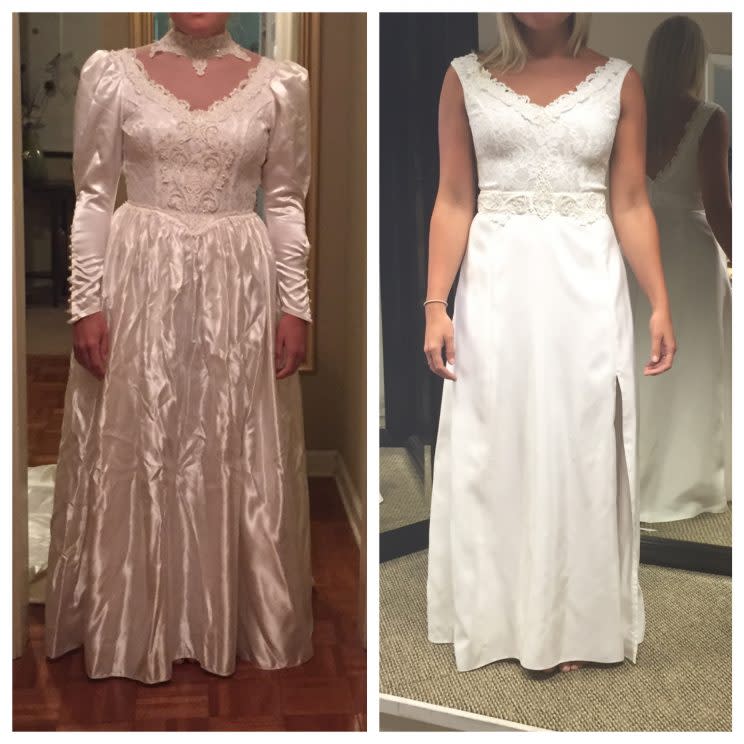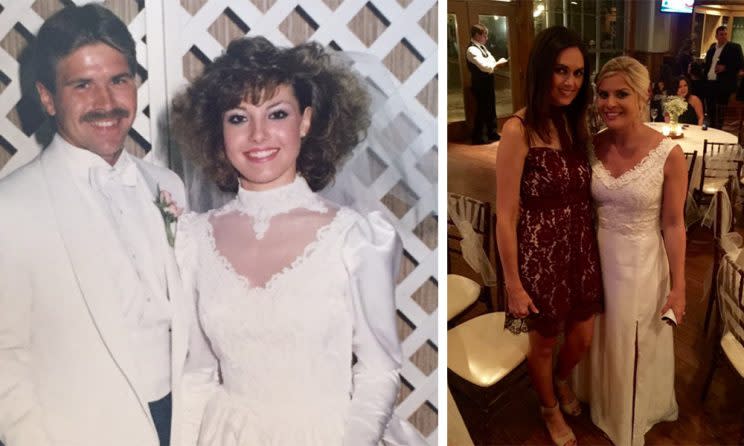Bride Totally Transforms Her Mother’s ’80s Wedding Gown

When you think of outdated wedding dresses you’d never wear, is your mother’s gown from the ’70s or the ’80s the first one that pops into your head? That was pretty much the case for Allie Ware, a news anchor for WAPT in Jackson, Miss.
“We used to watch [TLC’s Something Borrowed, Something New], where they remade mothers’ wedding dresses,” Ware tells Yahoo Style. “She was like, ‘I would love for you to do that,’ and I was like, ‘No!‘ Her dress was definitely ’80s, and definitely not something that I would wear.”
But after she’d chosen a new dress for her wedding ceremony, Ware thought she might be able to do something with her mother’s puffy-sleeved satin dress from 1986. She took it out from under a bed in her grandmother’s house without telling her mother.

“I guess I did steal it, in a sense,” Ware admits. She took it to the woman tailoring her other dress (who wishes to remain anonymous) and gave her free rein. The seamstress removed the sleeves and bow in back, and flipped the skirt around, so the outdated satin was on the inside. In two weeks, she had a dress as good as new to wear during her reception.
On her wedding day, Oct. 22, Ware surprised her mother, first with a piece of fabric from the gown for wrapping the bouquet, and then with the dress itself. “She loved it. She cried — but she cried the whole weekend,” Ware recalls. “It was special, in that I could have a piece of her with me on my wedding day. Maybe one day, somebody will wear it again in the family.”

In order to get more information on what other brides should think about when considering whether to alter their mother’s gown, Yahoo Style spoke with Carissa Suter, owner of The Gilded Thimble in Bedford, Va.
Material is what matters most
“If it’s a fabric that the bride loves, that’s going to be more of a green light than if she says, ‘I hate the main fabric,'” Suter says. She can work with every problem but that one, she says.
Dry rot is a deal-breaker
“If the fabric is so old that if there’s any pressure put on the seams, the thread or the fabric rips, then it’s a no-go,” she explains, although if you just want to wear the dress briefly for the first dance, you might be able to pull it off.

How comfortable are you — and your mother — with cutting?
Some gowns can be altered along their original seams, but if you’re changing the waistline or shape of the skirt, your seamstress will have to get out the scissors and make major cuts. This can be difficult for the original owner to witness.
“Sometimes, mid-process, the bride will start taking the gown in a different direction — that the mother wasn’t quite picturing — and the mother doesn’t necessarily agree with the direction the design is going in,” Suter notes. “The mother often will feel she has more of a say in the design direction because it was her dress. It’s a little more emotional for her. … It’s almost like watching surgery. Some people want to watch, and some don’t.”
Sleeves, bows, and pearls are the first to go
Simply by removing those, you’ve updated the dress by three decades.
The lace can stay
“Venice lace usually holds up pretty well,” Suter says, who also finds ways to reuse lace that she’s removed from other parts of the gown. “It’s usually in pretty good condition.”
Altering a vintage dress can be less expensive than altering a new dress
“It’s a very fast process for the vintage gowns, because they’re almost always unlined,” Suter says. “A modern dress we have to alter the outer layers, and then the inner layers, just like it. It’s like two dresses.”
The fact that the process is relatively inexpensive means you might be able to make a great compromise, as Ware did: Wear your own original gown, and honor your mother for a special moment in your wedding.
Follow us on Instagram, Facebook, and Pinterest for nonstop inspiration, delivered fresh to your feed, every day.
